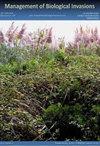南非宠物贸易中的非本地小型哺乳动物物种
IF 1.2
4区 环境科学与生态学
Q3 BIODIVERSITY CONSERVATION
引用次数: 5
摘要
非本地小型哺乳动物是世界上最受欢迎的宠物交易物种之一。在大多数国家,这些哺乳动物中的一些通过各种宠物贸易释放和逃跑而成为入侵性动物。在南非,一些非本地的小型哺乳动物被引入宠物贸易。我们评估了2018年9月至2019年南非非本土小型哺乳动物的销售情况,以确定它们在网上和宠物店的交易数量和程度。共有7个网站记录了7个分类目24个物种的2681个个体。在实体宠物店,122家宠物店共记录了7目16种19391只宠物。啮齿动物和灵长类动物在网上和宠物店都是最占优势的群体。交易中最常见的小型哺乳动物是挪威大鼠褐家鼠(Rattus norvegicus)、豚鼠Cavia porcellus、欧洲家兔Oryctolagus cuniculus和家鼠musculus。价格从9.00 zarar到12000 zarar不等,啮齿类动物的价格相对较低。与最不丰富的物种相比,交易最丰富的物种相对便宜,CITES物种比非CITES物种更昂贵。在南非,以低价交易的高丰度物种以及通过宠物贸易释放和逃逸的入侵历史构成了入侵风险。因此,它们的交易应该受到严格监管。本文章由计算机程序翻译,如有差异,请以英文原文为准。
Non-native small mammal species in the South African pet trade
Non-native small mammals are amongst the most popular species traded as pets around the world. Some of these mammals have become invasive through various pet trade releases and escapees in most countries. In South Africa, several non-native small mammals have been introduced for pet trade purposes. We assessed the sale of non-native small mammals in South Africa from September 2018 to 2019 to determine their abundance and degree of trade online and in pet shops. A total of seven websites were recorded selling 2,681 individuals representing 24 species belonging to seven taxonomic orders. For physical pet shops, 19,391 individuals representing 16 species and seven orders were recorded from 122 pet shops. Rodents and primates were the most dominant groups in both online and pet shops. The most common small mammal species traded were the Norwegian rat Rattus norvegicus , the guinea pig Cavia porcellus , the European rabbit Oryctolagus cuniculus and the house mouse Mus musculus . Prices ranged from ZAR9.00 to ZAR12,000.00, with rodents offered at relatively low prices. The most abundant species traded were relatively cheap when compared with the least abundant species and CITES species were more expensive than non-CITES species. Species with high abundances traded at low prices and have a history of invasion through pet trade releases and escapes pose an invasion risk in South Africa. Therefore, their trade should be strictly regulated.
求助全文
通过发布文献求助,成功后即可免费获取论文全文。
去求助
来源期刊

Management of Biological Invasions
Agricultural and Biological Sciences-Ecology, Evolution, Behavior and Systematics
CiteScore
3.40
自引率
6.70%
发文量
21
审稿时长
16 weeks
期刊介绍:
Management of Biological Invasions, established in 2010 by Dr. Elias Dana, is an open access, peer-reviewed international journal focusing on applied research in biological invasions in aquatic and terrestrial ecosystems from around the world. This journal is devoted to bridging the gap between scientific research and the use of science in decision-making, regulation and management in the area of invasive species introduction and biodiversity conservation.
Managing biological invasions is a crisis science, with Management of Biological Invasions aiming to provide insights to the issues, to document new forms of detection, measurements and analysis, and to document tangible solutions to this problem.
In addition to original research on applied issues, Management of Biological Invasions publishes technical reports on new management technologies of invasive species and also the proceedings of relevant international meetings. As a platform to encourage informed discussion on matters of national and international importance, we publish viewpoint papers that highlight emerging issues, showcase initiatives, and present opinions of leading researchers.
 求助内容:
求助内容: 应助结果提醒方式:
应助结果提醒方式:


